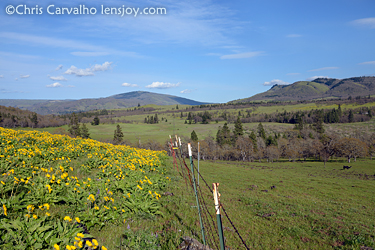







![]()
 |
Next | ||
The Columbia Gorge is known for its fields of yellow balsamroot and purple lupine flowers. Most people don't know that there used to be many more of them. Today, these vistas can only be found on a few areas of protected land such as Tom McCall Preserve. You'd need to go back to the days before colonial settlement to find their original extent. Once the Oregon Trail opened up, settlers brought cattle, sheep, and horses with them. Balsamroot are delicious and don't regrow well when grazed in springtime,1 even though the roots of established plants can be up to 40 years old.2 The roots can be up to 4 inches wide and 8.8 feet deep. Balsamroot leaves are high in protein and the sprouts are high in vitamin C, making them important food sources for Native American peoples. Indians also used them medicinally to treat a variety of ailments.3
Lupines are toxic, causing birth defects in sheep and to a lesser extent in
cattle. For that reason, ranchers often removed them from pastures.
The picture below shows a pasture bordering an ungrazed area with the obvious
impact. 
We do need pastures, so what can be done to balance preservation of the landscape with the need for food, wool, and livestock recreation? One way is to set aside sensitive landscape and replant wildflowers. Where grazing is allowed, fencing must be maintained to limit impact. Private landowners interested in improving habitat are becoming aware of the value of these historic fields and can replant native plants on their own property.
This scene includes Oregon's Mt. Hood in the distance. To protect it from damage I'm not disclosing it. I prefer that others do their own searching and as a result, form a closer relationship with the beauty and fragility of the land and earn the sense of exploration and discovery that can't be duplicated from Internet searches, GPS, and snooping at image metadata.

|
|||
|
1Mueggler, Walter F. 1950. Effects of spring and fall grazing by sheep on vegetation of the upper Snake River plains. Journal of Range Management. 3: 308-315. 2Treshow, Michael and Kimball Harper. Longevity of perennial forbs and grasses. OIKOS 25: 93-96. Copenhagen 1974. 3 http://www.fs.fed.us/database/feis/plants/forb/balsag/all.html
|
|||
| Info: Chromira digital print of Velvia 100F 4x5 chrome, Fuji Crystal Archive CD paper | |||
